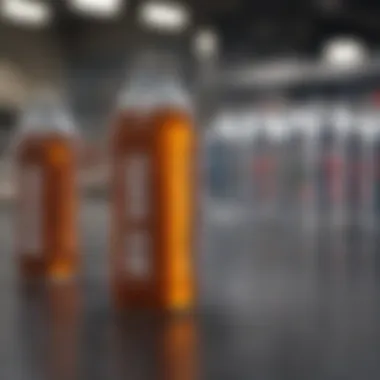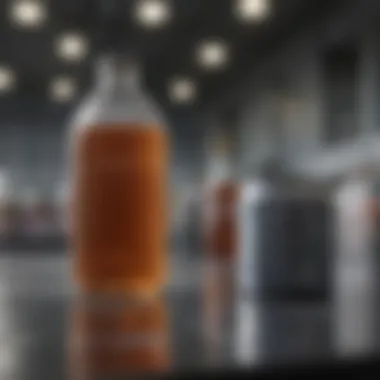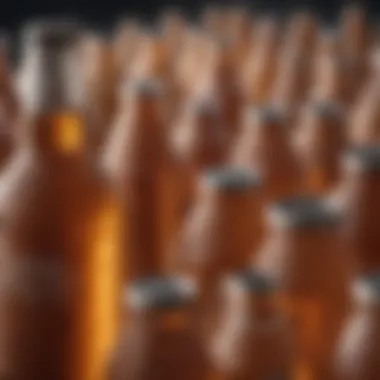Exploring Beverage Container Manufacturing Insights


Intro
The landscape of beverage packaging has evolved significantly in recent years. Beverage container manufacturers play a crucial role in this industry. This article delves into the complex interplay of various elements defining this sector. By analyzing the technologies, materials, and environmental challenges faced, readers will gain a clear understanding of the industry’s present and future.
Beverage containers come in myriad forms, from glass bottles to innovative biodegradable materials. Each option presents its own set of advantages and drawbacks. The rapidly changing market demands constant adaptation from manufacturers, who must balance consumer preferences with sustainability efforts.
In addition, regulatory factors influence production practices significantly. These regulations can dictate the types of materials used, methods of recycling, and overall environmental impact. The dynamic nature of these rules requires manufacturers to be vigilant and flexible.
Furthermore, consumer demand for more sustainable packaging solutions drives innovation in this field. Manufacturers must continuously evaluate new methods and materials to meet these expectations. This article aims to explore the intricacies of the beverage container manufacturing sector and provide insightful analysis for students, researchers, educators, and professionals alike.
Prelude to the Industry
Understanding the beverage container manufacturing industry is essential for grasping its broad implications on consumer behavior, environmental considerations, and technological evolution. Beverage containers play a crucial role in the distribution and enjoyment of drinks worldwide. Their design, materials, and production methods affect not only the quality of the beverages but also impact the environment and sustainability efforts.
This article delves into various aspects of the industry, such as historical context, current market overview, and evolving consumer preferences. Exploring these themes provides valuable insights for students, researchers, educators, and professionals interested in manufacturing, sustainability, or market dynamics.
Historical Context
To comprehend the present state of beverage container manufacturing, it is necessary to consider its origins. The journey of beverage containers began thousands of years ago with the use of natural materials such as clay and animal skins. Ancient civilizations utilized these primitive forms of containers to store and transport liquids.
With the advent of glassblowing techniques around 2000 BC in Egypt, glass containers became prominent. These were favored for their non-reactive qualities and aesthetic appeal. As time progressed, the industrial age brought significant developments. The introduction of pasteurization in the 19th century increased the importance of reliable packaging. This led to the mass production of metal cans and glass bottles.
In the latter part of the 20th century, the rise of plastic revolutionized the industry. Material properties like lightweight and flexibility made plastic containers widely popular. However, this shift brought forth challenges regarding waste management and environmental concerns, which continue to shape the industry today.
Current Market Overview
As of now, the beverage container manufacturing market is multifaceted and dynamic. It encompasses various materials, including glass, plastic, metal, and composite options. Each material has unique benefits and limitations that cater to different consumer needs and preferences.
Key points of the current market landscape include:
- Market Growth: Demand for beverage containers is driven by increased consumption of ready-to-drink products. Notably, the shift towards healthier lifestyle choices stimulates the market for bottled water and functional beverages.
- Sustainability Trends: Consumers are increasingly prioritizing sustainability. Many companies are investing in eco-friendly packaging solutions. The emphasis on recycled materials is reshaping production practices.
- Technological Innovation: Advanced manufacturing technologies, including automation and robotics, are enhancing efficiency and reducing costs.
- Regulatory Landscape: Government regulations regarding packaging waste and recycling are affecting production methodologies. Compliance demands have made manufacturers focus on sustainable practices.
"The beverage container industry is not just about packaging; it's about adaptability and innovation in a rapidly-changing market context."
In summary, the beverage container manufacturing industry holds substantial relevance in our interconnected world. By examining its history and present dynamics, we can anticipate future trends that may evolve in tandem with consumer preferences and environmental imperatives.
Types of Beverage Containers
Beverage containers play a crucial role in the consumption and distribution of drinks worldwide. They are vital not only for preserving the quality of the contents but also for ensuring safety and compliance with regulatory standards. The choice of container can influence consumer preferences, brand perception, and environmental impact, making it essential to explore the various types available in the market today. This section highlights the primary types of beverage containers, their characteristics, and their applications.
Glass Containers
Glass containers are a popular option for packaging beverages. They are valued for their ability to maintain flavor integrity and provide a barrier against external factors such as air and light. Glass doesn't leach chemicals, which can be a concern with other materials. Notable characteristics include:
- Recyclability: Glass is infinitely recyclable without loss of quality, making it an environmentally friendly choice.
- Aesthetics: Glass offers a premium look and feel, often used for products like wine, beer, and artisanal drinks.
- Inertness: Glass is chemically inert, ensuring that it does not interact with the contents.
While glass is heavy and can break more easily compared to other materials, its qualities make it a top choice for many manufacturers aiming for high-quality packaging.
Plastic Containers
Plastic containers come in various forms, including bottles, jugs, and pouches. They are lightweight and offer convenience in terms of handling and transportation. Plastics such as polyethylene terephthalate (PET) and high-density polyethylene (HDPE) are commonly used. Their benefits include:
- Cost Efficiency: Plastic containers are generally cheaper to produce than glass and metal counterparts.
- Versatility: They can be molded into different shapes and sizes, catering to diverse beverage types.
- Lightweight: Their reduced weight aids in lowering shipping costs and energy consumption.
Despite these advantages, concerns over plastic pollution and recycling challenges are significant issues for the industry. Many companies are now exploring biodegradable options or enhancing recycling methods to mitigate these effects.
Metal Containers


Metal containers, notably aluminum and steel, are commonly used for beverages like soft drinks and canned beers. They hold several advantages:
- Durability: Metal containers can withstand pressure and resist damage, making them ideal for carbonated beverages.
- Barriers: Aluminum provides excellent barrier properties against oxygen and light, which helps in preserving beverage quality.
- Recyclability: Aluminum is highly recyclable, and recycling it saves energy compared to producing new metal.
However, metal containers can be prone to corrosion if not coated properly, and they may affect the taste of certain beverages due to chemical reactions.
Composite Containers
Composite containers represent an innovative fusion of materials, combining offerings from glass, plastic, and metal. These containers can provide several unique benefits:
- Multi-layer Protection: They can deliver superior barrier properties, keeping beverages fresh longer.
- Lightweight with Robustness: These containers can be lighter than traditional glass while still providing strength and durability.
- Branding Opportunities: Their unique design allows for creative branding and marketing platforms.
On the downside, composite containers can be more complex to recycle due to the mixture of materials. As manufacturers aim for sustainability, the recycling process for these containers is an area of ongoing research and development.
In summary, the selection of beverage container types involves a balance of functionality, cost, and environmental impact. Understanding these types helps stakeholders make informed decisions that align with their branding and sustainability goals.
Materials Used in Manufacturing
The selection of materials in beverage container manufacturing is crucial for the overall performance and environmental impact of the products. The right materials influence durability, cost-effectiveness, and consumer safety. Understanding these materials requires a closer look at both primary raw materials and recycled options.
Primary Raw Materials
Properties
Each material has unique properties that make it suitable for specific applications. Glass is known for its impermeability, meaning it does not allow gases or liquids to permeate through. This property preserves the flavor and freshness of drinks. Plastic, on the other hand, is lighter and more flexible. It can be molded into diverse shapes but may leach chemicals if not properly formulated. The resilience of metal containers, like aluminum, is another important characteristic, allowing for impact resistance during transport and handling while being lightweight.
Applications
The different properties of these raw materials lead to diverse applications. Glass containers are typically used for premium beverages like wine or craft beer, where the preservation of flavor is vital. Plastic containers are ubiquitous in the soft drink market due to their light weight and low cost. Metal containers, particularly aluminum, are commonly used for canned drinks because of their durability and suitability for high-pressure contents. Each material and its specific application carry advantages and drawbacks, shaping consumer choices in the marketplace.
Recycled Materials
Advantages
Recycled materials offer significant benefits, mainly in reducing the environmental footprint of beverage container production. For instance, using recycled glass requires less energy than producing new glass from raw materials. This makes energy consumption a key advantage of recycling. Furthermore, utilizing recycled plastics reduces waste and often lowers production costs. Manufacturers increasingly adopt these materials to align with sustainability goals and meet consumer demand for eco-friendly products.
Limitations
Despite the advantages, the use of recycled materials also presents challenges. Recycled plastics can sometimes have inferior properties compared to virgin materials, leading to concerns about strength and safety. Moreover, the quality of recycled materials can vary, depending on their source and processing methods. These limitations might impact manufacturers’ choices, making them cautious about integrating recycled options into their product lines. Furthermore, regulatory standards for food safety can complicate the use of recycled materials.
In summary, understanding the materials used in beverage container manufacturing is essential for comprehending the industry’s operational dynamics. The right balance of primary and recycled materials can drive both sustainability and product quality.
Technological Advances in Manufacturing
Technological advances in manufacturing play a critical role in the beverage container industry. Innovations are reshaping how containers are produced, leading to improvements in efficiency, sustainability, and product quality. As manufacturers navigate this evolving landscape, understanding these technologies becomes essential for making informed decisions about production processes and materials.
Automation and Robotics
Automation stands at the forefront of modern manufacturing processes. Robotics has transformed traditional production lines, making them faster and more accurate. Automated systems can handle repetitive tasks, such as sorting and assembling containers, which significantly reduces human error.
The benefits of automation include:
- Increased Efficiency: Automated systems operate at a consistent pace, leading to higher output rates.
- Cost Reduction: Machines can often perform tasks more cheaply than human workers over time, lowering overall operational costs.
- Enhanced Precision: Robotics can achieve levels of accuracy that are difficult for humans, especially in material handling and placement.
However, the shift toward automation is not without challenges. Companies must invest significantly in technology and training to maximize the potential of these systems. Furthermore, there is the need to address job displacement concerns among the workforce due to the rising use of autonomous machinery.
3D Printing Applications


3D printing is another technological advance making waves in the beverage container sector. This technology allows for the on-demand production of components, reducing the need for large inventories. With 3D printing, manufacturers can design and produce complex shapes that are often impractical with traditional methods.
The advantages of 3D printing are manifold:
- Customization: Offers the ability to create tailored designs for specific consumer preferences.
- Rapid Prototyping: Speeds up the development process for new container designs, allowing for quicker testing and iteration.
- Material Waste Reduction: 3D printing utilizes material more efficiently, contributing to sustainability efforts.
Despite its promising benefits, challenges remain for 3D printing in large-scale production. The speed of printing can be slower compared to traditional methods, which may not meet high-volume demands. Additionally, regulatory issues regarding food safety and material properties must be firmly established to ensure the reliability of 3D printed beverage containers.
"The integration of advanced technology, such as automation and 3D printing, is revolutionizing beverage container manufacturing, addressing the need for more sustainable and efficient practices."
Sustainability and Environmental Impact
Sustainability has emerged as a cornerstone in the discussion around beverage container manufacturing. Awareness about environmental impacts continues to grow, driving both consumers and manufacturers to consider the long-term effects of production processes and materials used. This section examines crucial elements related to sustainability, including pollution reduction, resource conservation, and the influence of changing consumer preferences on container production.
Life Cycle Analysis of Beverage Containers
Life Cycle Analysis (LCA) functions as a comprehensive methodology that evaluates the environmental impact of beverage containers from creation to disposal. By scrutinizing every phase—raw material extraction, manufacturing processes, distribution, consumption, and end-of-life disposal—stakeholders gain detailed insights.
Key components of an effective LCA include:
- Raw Material Selection: The choice between materials like glass, plastic, and metal significantly affects the ecological footprint of the final product.
- Energy Consumption: Evaluating the energy used during manufacturing processes helps identify areas for efficiency improvements.
- Transport Emissions: Transportation contributes to the carbon footprint, making local sourcing an attractive option for sustainable practices.
- End-of-Life Options: Assessing recycling capabilities and biodegradability, ensures that products minimize landfill contributions.
Thus, LCA not only aids companies in making informed decisions but also aligns their objectives with broader sustainability goals.
Regulatory Standards and Compliance
Regulatory standards play a pivotal role in shaping the sustainability landscape of beverage container production. The introduction of policies covering safety and environmental performance is essential for minimizing harmful effects. Many countries or regions enforce regulations requiring manufacturers to adhere to protocols that promote recycling and reduce pollution.
Significant aspects of regulatory compliance include:
- Recycling Mandates: Many jurisdictions implement laws aimed at increasing the recycling rate of beverage containers.
- Safety Guidelines: Regulations ensure containers do not leach harmful substances into beverages.
- Environmental Reporting: Manufacturers are often required to disclose their sustainability efforts and environmental impact metrics.
The compliance with regulatory standards serves not only to safeguard the environment but also to build consumer trust. As public awareness increases, manufacturers seen committing to sustainability thus gain a competitive edge in the marketplace.
In summary, understanding sustainability and regulatory standards is essential for the future of beverage container manufacturing, propelling the industry toward more ecologically responsible practices.
Consumer Preferences and Market Trends
Consumer preferences and market trends play a crucial role in shaping the beverage container manufacturing industry. These factors determine the materials used, the design of containers, and even the technologies adopted by manufacturers. Understanding consumer behavior provides insights into market demands, which can guide businesses in making informed decisions.
Shifts in Consumer Behavior
In recent years, there has been a significant shift in how consumers approach beverage choices. Health awareness has surged, leading to a preference for natural and organic products. Consumers are now more discerning, often checking labels for ingredients and sourcing. This increased scrutiny extends to how beverages are packaged. For instance, there is a notable trend toward eco-friendly packaging. Many consumers actively seek out brands that prioritize sustainability, leading to higher demand for biodegradable materials and recyclable containers.
Additionally, convenience has become a priority. Single-serving packaging and portable containers have gained popularity as lifestyles have become more fast-paced. Beverage manufacturers are responding by innovating designs that accommodate on-the-go consumption. There is also a rise in subscription services, where consumers receive their favored products delivered regularly. This highlights a shift toward personalized consumption experiences and brand loyalty.
Emerging Market Demands
Emerging markets present unique demands that significantly impact the beverage container sector. As incomes rise in developing countries, there is a growing middle class that prioritizes quality and variety in their beverage choices. This change demands more diverse packaging solutions. Manufacturers are challenged to provide products that cater to local tastes while also ensuring that packaging is functional and appealing.
Trends are also influenced by cultural factors. For example, in some regions, traditional drinks are gaining a revival, presenting opportunities for manufacturers to create authentic, culturally relevant packaging. There is a notable demand for innovation as brands strive to stand out in a crowded marketplace. Incorporating technology, such as QR codes or augmented reality on packaging, can provide interactive experiences and useful information about the beverage inside.
"Understanding consumer preferences is essential for beverage container manufacturers to stay ahead in an ever-evolving market."
Challenges Facing Beverage Container Manufacturers
The beverage container manufacturing industry encounters numerous challenges that affect its operations and profitability. Understanding these challenges is crucial for professionals in the field, as they can significantly impact production processes, market strategies, and overall sustainability initiatives. This section delves into three major areas affecting manufacturers: supply chain disruptions, competition in a global market, and the need for technological adaptation.


Supply Chain Disruptions
Supply chain disruptions are a pressing challenge for beverage container manufacturers. These disruptions can arise from various factors, including natural disasters, geopolitical events, and the ongoing effects of the COVID-19 pandemic. The fragility of supply chains has been exposed over the past few years, leading to increased costs and delays in obtaining materials.
For example, many manufacturers rely on specific raw materials, such as glass or aluminum, which may become scarce due to market volatility or political issues in supplier countries. Consider the impact of shipping delays. Getting materials from international suppliers can often take longer than anticipated, which disrupts production schedules and affects delivery timelines to clients.
Therefore, manufacturers must develop strategies to foster supply chain resilience. This may include diversifying suppliers, investing in local material sourcing, and enhancing inventory management practices. These steps are crucial to mitigating the risks associated with supply chain disruptions.
Competition in a Global Market
The beverage container manufacturing sector is characterized by intense competition, both domestically and globally. Many firms vie for market share by innovating their products and enhancing their production efficiencies. This competition often leads to price wars, which can strain profit margins.
Additionally, new entrants from developing nations may offer lower prices, making it challenging for established companies to maintain their market positions. Therefore, manufacturers must differentiate their products. This might involve adopting sustainable practices or using innovative designs that cater to changing consumer preferences.
Moreover, global competition pushes the industry towards greater efficiency and productivity. Companies adopting advanced technologies in production processes can remain competitive. For example, manufacturers using automation technology can reduce labor costs and improve output efficiency.
Technological Adaptation
The rapid pace of technological advancement poses both opportunities and challenges for beverage container manufacturers. Keeping up with the latest technology is vital for remaining competitive in the market. Automation, AI, and data analytics are increasingly becoming essential in production lines.
Manufacturers face a pressing need to invest in new technologies that enhance efficiency. However, implementing new technologies often requires significant investment and restructuring. Some companies may hesitate to adopt these due to perceived risks or the high cost of transition.
At the same time, those who successfully adapt can leverage technology to improve product quality and reduce waste. For instance, utilizing AI in logistics can optimize supply chain operations, reducing costs and enhancing delivery times.
Future Directions in Beverage Container Manufacturing
The beverage container manufacturing sector is undergoing significant transformations, provoked by shifts in consumer preferences and technological advancements. Understanding the future directions of this industry is vital for manufacturers, investors, and academics alike. This section highlights the expected innovations and global trends that will shape the industry in the coming years.
Innovations on the Horizon
Innovation is pivotal for maintaining competitiveness in beverage container manufacturing. Emerging technologies are set to streamline production processes and improve the sustainability of products. Key areas to watch include:
- Smart Packaging: As demand for more information on products increases, smart packaging solutions are emerging. These containers can provide real-time information about product freshness, environmental conditions, and even communicate with consumers through smartphones.
- Biodegradable Materials: With heightened awareness of environmental impacts, companies are investing in biodegradable materials for manufacturing. These new materials could reduce landfill contributions significantly.
- Enhanced Recycling Systems: Innovations in recycling technology are also crucial. For example, advanced sorting technologies can increase recycling rates and the quality of recycled materials, making it more feasible to use recycled content in new containers.
These innovations hold potential not only to address sustainability concerns but also to enhance consumer engagement through intelligent packaging.
Global Trends Impacting the Industry
Global dynamics influence the beverage container manufacturing landscape. As markets evolve, certain trends are becoming increasingly pronounced:
- Consumer Preferences: Growing concern about sustainability is prompting consumers to favor recyclable and reusable containers. This shift is leading manufacturers to rethink their design and production strategies.
- Emerging Markets: As developing countries grow economically, there is increased demand for beverage products. This will likely result in more localized manufacturing strategies to meet regional needs efficiently.
- Legislation and Regulation: Stricter regulations regarding environmental impact are shaping manufacturing practices. Companies must adapt to comply with these new directives, which often prioritize reduce, reuse, and recycle principles.
"The future of beverage container manufacturing hinges on adapting to consumer values and environmental responsibilities."
In summary, innovators and manufacturers must closely monitor these trends and actively respond to changes. By embracing advancements and aligning with evolving consumer expectations, the beverage container industry can ensure sustainable growth and continued relevance in a rapidly changing market.
End
The conclusion of this article serves as an essential reflection on the complexities surrounding beverage container manufacturing. Here, we summarize the critical insights discussed throughout the text, emphasizing the interplay between various factors, such as materials, technologies, and sustainability challenges. Understanding these elements is crucial not only for industry professionals but also for educators and researchers who seek to navigate this multifaceted field.
Summary of Key Points
Throughout the article, we underscored some vital points about beverage container manufacturers:
- Historical Context: Understanding the evolution of the industry is crucial. From early glass bottles to modern sustainable practices, historical insights inform present strategies.
- Materials Used: Different materials, including glass, plastic, metal, and composites, have unique properties and applications that affect consumer choices and environmental impacts.
- Technological Advances: Automation and innovative manufacturing techniques enhance production efficiency but also raise questions about job displacement and skills.
- Sustainability: The significance of life cycle analyses and compliance with regulatory standards cannot be overstated, marking a pivotal shift towards environmentally friendly practices.
- Future Directions: Identifying current trends and emerging demands is crucial for manufacturers to remain competitive.
Final Thoughts on Industry Future
Looking ahead, the beverage container manufacturing industry must adapt to rapid changes. The impacts of climate change and shifts in consumer preferences will continue to pressure manufacturers. Innovations in materials such as bioplastics may revolutionize the sector, but challenges related to recycling and waste management remain significant.
With increasing regulatory scrutiny and consumer awareness about sustainability, manufacturers must prioritize eco-friendly practices. The challenge lies in balancing profitability with environmental responsibility. Ultimately, this industry will not only shape future beverage packaging but also contribute to broader shifts towards sustainability in the global economy.
"As the beverage container industry evolves, its ability to innovate sustainably will determine its success in a complex market environment."
Through this article, we hope to provide insights that encourage further discussion and research on this impactful industry.







